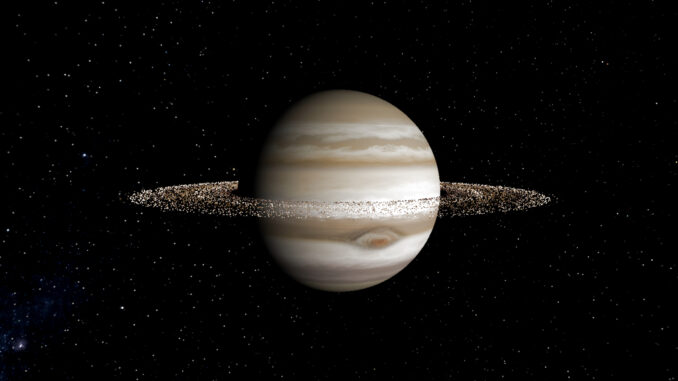
For years, scientists have puzzled why Jupiter would not have thick, shiny jewelry like neighboring Saturn does, and now they suppose they could realize why.
Though Jupiter does have faint, nebulous jewelry — as visible in current pictures from the James Webb Space Telescope — they are not almost as outstanding as the ones of Saturn or Uranus. In fact, they’re so flimsy that they can not be visible with preferred astronomical equipment. But now, the usage of a complicated pc simulation, a group of scientists has determined a likely reason for why Jupiter’s jewelry aren’t as outstanding as its neighbors’: Jupiter’s moons might also additionally have avoided ice from settling across the huge planet.
“It’s lengthy afflicted me why Jupiter would not have even greater wonderful jewelry that might positioned Saturn’s to shame,” Stephen Kane, an astrophysicist on the University of California, Riverside who led the research, stated in a statement. “If Jupiter did have them, that they had seem even brighter to us, due to the fact the planet is a lot nearer than Saturn.
“We did not realize those ephemeral jewelry existed till the Voyager spacecraft went past, due to the fact we could not see them,” he added.
Kane desired to determine out why Jupiter’s jewelry are so faint and if the fueloline massive as soon as had thicker jewelry and in some way misplaced them. To look at those questions, he and his colleagues created a dynamical simulation that might recall the orbit of Jupiter in addition to the orbits of the planet’s 4 predominant Galilean moons — Ganymede, Callisto, Io and Europa.
Saturn’s jewelry are composed in particular of ice, a number of which became brought to the planet with the aid of using comets , which might be additionally made up in particular of ice. If moons orbiting a planet are huge sufficient, their gravity can reason ice to be ejected from orbit round that planet. These huge moons also can extrade the orbit of ice sufficient to reason this cloth to crash into them.
“We determined that the Galilean moons of Jupiter, one in every of that’s the most important moon in our sun machine [Ganymede], could right away smash any massive jewelry that would shape,” Kane stated. “Massive planets shape huge moons, which prevents them from having widespread jewelry.”
The researchers’ simulation has additionally led them to suppose it is not likely that Jupiter had massive jewelry at any time in its records.
Ring structures round planets are not simply beautiful; they also can be a beneficial manner for astronomers to look at the records of a planet and any collisions with moons or comets that it could have experienced. This is due to the fact the composition of the cloth withinside the jewelry and their form and length deliver tips as to the activities that created them.
The researchers now intend to apply their simulations to look at the hoop machine of Uranus. This research might also additionally display how lengthy Uranus’ jewelry will closing and why it orbits the solar in another way than the alternative planets withinside the sun machine — the ice massive orbits the solar tipped on its side, and astronomers suppose this uncommon tilt is the end result of a collision with any other body. Uranus’ ring machine might be the remnants of this impact.
“For us astronomers, they’re the blood spatter at the partitions of against the law scene,” Kane stated. “When we study the jewelry of massive planets, it is proof some thing catastrophic came about to position that cloth there.”
The group’s findings were well-known for booklet in The Planetary Science Journal, and a preprint model is to be had through the arXiv database.

Leave a Reply